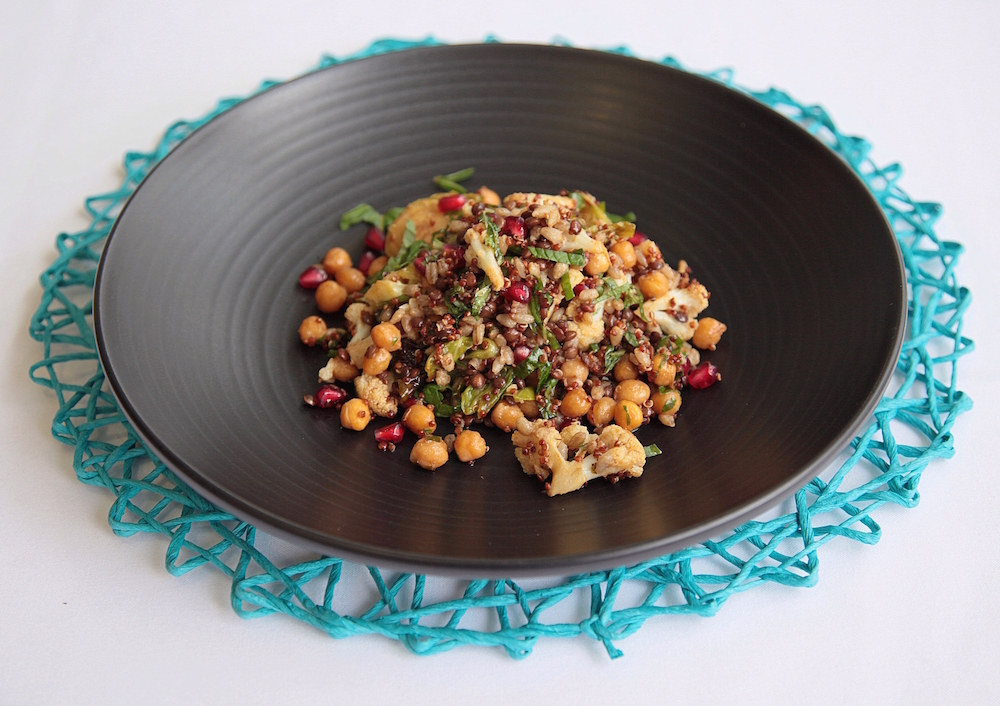- Details

The winner of the 2016 International Year of Pulses (IYP) Australian Signature Dish Recipe Competition is a feast for all the senses, and embodies the vibrant lifestyle that Australia is famous for across the globe.
Unveiled at the 2015 Australian Grains Industry Conference Gala Dinner in Melbourne last night, IYP Australian advocate Simone Bryant announced the National Signature Dish Recipe Competition winner. The winning dish was a quinoa, black lentil & roasted barley salad with chickpeas, cauliflower, brussel sprouts and pomegranate in apple cider vinegar submitted by Alison Victor from the Margaret River in WA.
Mrs. Victor was inspired to create this dish upon moving to Australia with her husband and son from Malaysia, "One of the first dishes I tasted upon moving to Australia was at our good friend's family farm where I first tried this mix of ingredients.
"I was blown away by the freshness of the ingredients and reinterpreted the salad to make it my own, adding pulses for a different flavor and to add more texture. My family love it, and when I saw the IYP recipe competition, I know I had to enter it."
After reviewing over 60 amateur recipe submissions from across Australia with fellow judge's renowned pastry chef Pierrick Boyer, food director at taste.com.au magazine Michelle Southan and leading dietician Emma Stirling, Mr Bryant declared the dish a standout entry.
"It was great to see so many entries for the Signature Dish Competition with outstanding creativity. The winning dish had tonnes of great flavours while incorporating plenty of protein with some other complementary grains and a fistful of fresh veggies - my kind of food" he said.
As the winner of the National Signature Dish, Mrs Victor will receive a $1000 cash prize and her recipe will be submitted as Australia's Signature Dish representing our cuisine alongside the global recipes from the other 40 participating nations.
Celebrating and driving pulse production and consumption in Australia is set to continue in the coming months, with the National Committee announcing the launch of the Australian Celebrations for the International Year of Pulses Gala Dinner on 17 September 2015 at the Melbourne Museum and a call for organisations to link their brand to the power of pulses. "
The International Year of Pulses represents a significant opportunity to showcase Australia as a key supplier of pulses globally while raising their overall awareness as a versatile, nutritious food" outlined Ms Georgie Aley, Australia's National Committee Chair for YP and Managing Director of the Grains & Legumes Nutrition Council.
The National Committee thanks IYP partner Blue Ribbon and their allied food company, Foods from the Earth, for their support of the 2016 International Year of Pulses in Australia.
Further information on the Australian IYP activities and sponsoring opportunities can be found at www.glnc.au/iyp/ or contact IYP Project Manager, Rebecca Freeman on 0414 844 425. Additional photos of the Australian Signature Dish and from the AGIC presentation available on request.
- Details
Jenny Chandler, a food blogger and cookbook enthusiast based out of Bristol, actively promotes the use of chickpeas in her articles and recipes. For her, chickpeas are the number one base ingredient for their earthy, nutty creaminess. Chandler also frequently uses chickpea flour or “gram” flour for making farinata or bhaji because it’s low-cost, easy to use and is a great substitute for those with certain food allergies.
Visit Jenny Chandler’s blog for plenty of advice when preparing chickpeas, and recipes that will blow your friends and family away.
- Details
Raghavan Sampathkumar, a contributor to the International Food Trader, was in an interview regarding the Indian pulses sector and expressed the need for a holistic understanding on the issues affecting the pulses value chain.
The interview, featured on the International Food Trader website, answers questions about policy overview, demand and consumption forecast, the need for innovations and ways to increase demand and production.
“Given the slow adoption of research output, one cannot but wonder if public investment in R&D is making any real impact on the ground despite having several initiatives such as the National Food Security Mission and Pulses Villages etc.” says Sampathkumar, “It is important to ensure research priorities are aligned with realities on the ground and what farmers can practically adopt to increase yields”
To read the full interview, visit the International Food Trader.
- Details
According to a webinar hosted by Baking & Snack on July 22nd, companies have begun reducing egg use in their recipes to save costs, and are replacing the ingredient using pulses. Proteins, hydrocolloids and starches may be combined to replace eggs, while still keeping the necessary emulsification, aeration, volume, structure and color in baked foods.
Pulses such as lentils, chickpeas, dried peas and dried beans are non-bioengineered and non-allergen with protein content ranging from 23.7% to 26.3%. The use of pulses in baking provides foam stability and foam expansion while having a low oil absorption capacity.
Replacing eggs with another ingredient is challenging, but can result in more cost effective recipes that are just as delicious and containing plant-based protein to attract the vegan conscious eater.
For the full story, visit the Food Business News.
